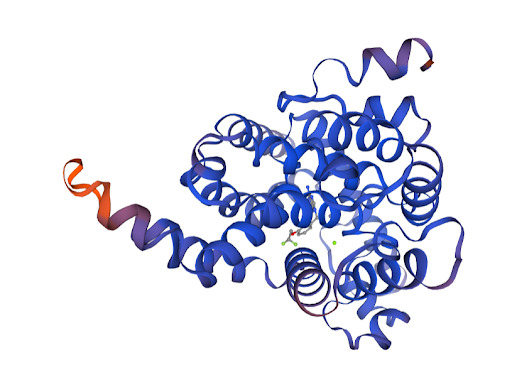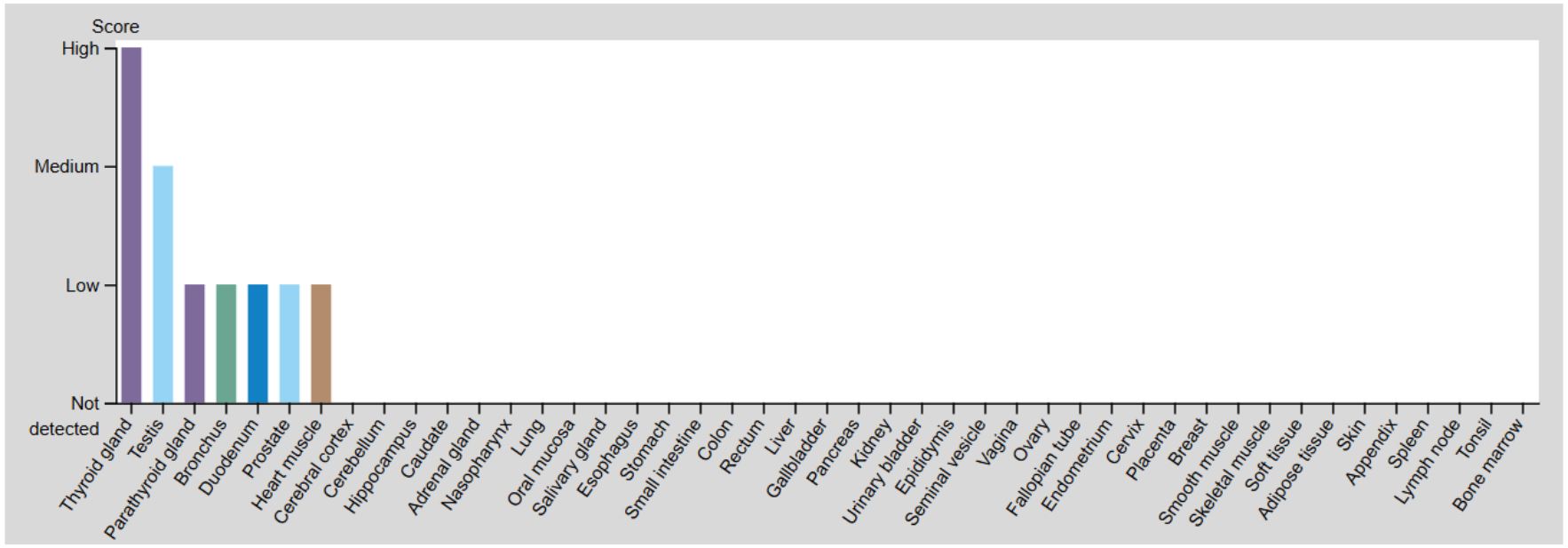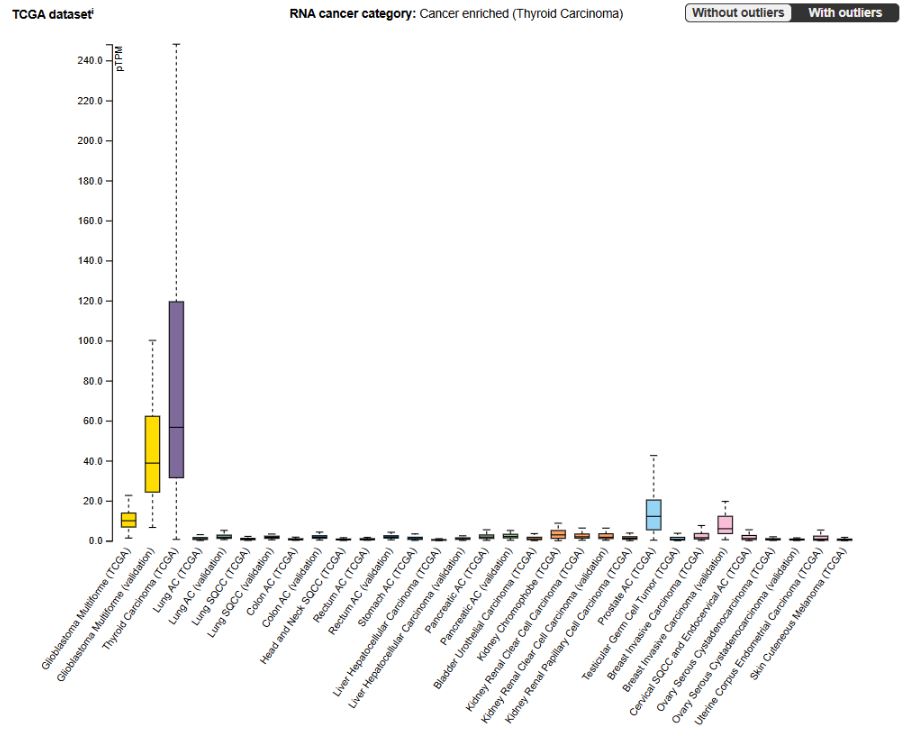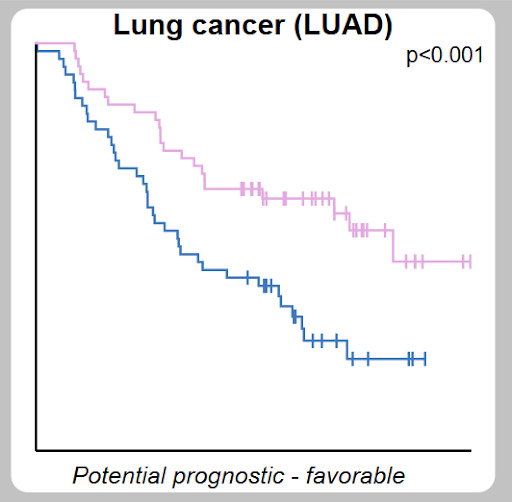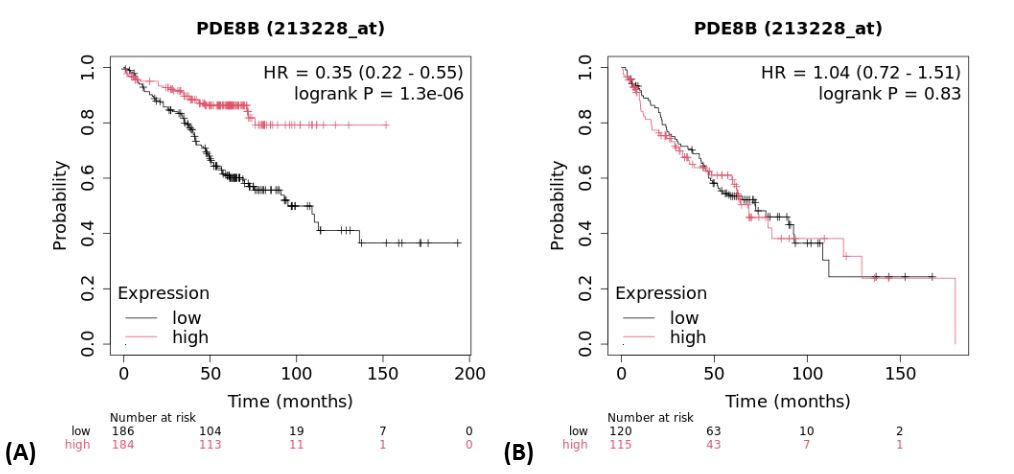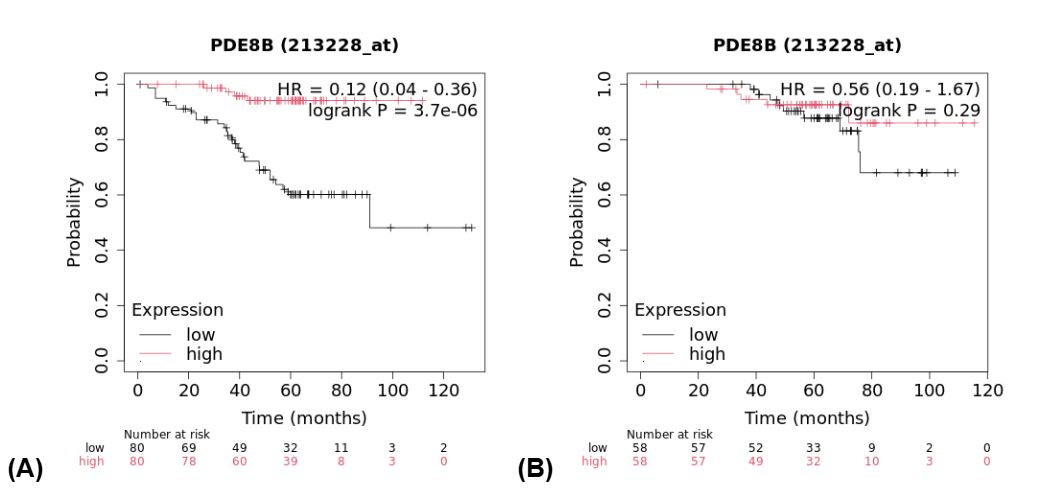Drawing upon our previous research updates, we are investigating the top-scoring genes with associations to various cancers as part of the Mapping Cancer Markers (MCM) project. This research update focuses on PDE8B (Phosphodiesterase 8B), a gene that is involved in hormone synthesis and has altered expression in diverse cancers.
Terminology
- Prognostic marker: A biological feature associated with clinical outcomes, such as survival or disease progression.
- Second messenger: A small molecule that is produced in response to a hormone or cell surface receptors. Second messengers amplify a signal by activating downstream proteins that produce a physiological response.
- mRNA: An intermediate product derived from DNA that can be processed further to produce functional proteins.
- p value: a number between 0 and 1 that shows how likely it is that a result happened by chance; a smaller p-value (typically below 0.05, denoted p < 0.05) suggests the result is likely due to a real effect rather than random variation.
Figure 1. Protein structure of PDE8B (UniProt).
Background
The MCM project is a large-scale initiative that aims to improve cancer treatment and research through the power of data. By comparing millions of tissue samples from both healthy individuals and cancer patients, we are investigating what drives cancer at the most fundamental level - the gene. This effort has been made possible due to the generous contributions of WCG volunteers, who play a crucial role in running the analyses that help us identify these genetic markers. As of May 6, 2025, MCM volunteers have generated over 2.6 billion results, which are integral to the overarching goals of identifying markers for early cancer detection and risk stratification. We are extremely grateful for your ongoing support!
Throughout the MCM project, we have identified 26 high-scoring genes that are enriched in lung cancer. We have explored other genes in previous articles, such as DYNLT1 and GCM1, but the focus of this research update is PDE8B.
PDE8B is a gene that makes a type of protein called a phosphodiesterase (PDE), which helps to control how cells respond to signals. PDEs work by breaking down small molecules inside the cell that act like messengers, helping the cell “understand” and react to outside signals from inside of them. PDE8B is in charge of monitoring the levels of a specific type of messenger called cyclic adenosine monophosphate (cAMP).
cAMP is a crucial intermediate in the cell, activating processes related to growth, metabolism, and hormone production. By regulating cAMP levels, PDEs play a balancing role in the body, preventing over-activation of hyperinflammatory or cancer-promoting signalling. Compared to other PDEs, PDE8B is very good at targeting cAMP specifically, making it a key regulator of cellular cAMP levels and in the body [PMID:18514160].
PDE8B is highly expressed in endocrine organs like the thyroid and testes (Figure 2), where it maintains balanced cAMP levels to regulate the production of various hormones. For example, in the thyroid, PDE8B helps to ensure appropriate levels of the thyroid stimulating hormone (TSH), triiodothyronine (T3) and thyroxine (T4) [PMID:18514160, PMID:20373981]. When PDE8B levels are too low, normal cell growth and metabolism are disrupted, which may lead to the development of thyroid disorders and cancer [PMID:18514160].
Alterations in PDE8B levels, both the genetic instructions (mRNA) and the protein itself, have been detected in various cancers. For example, PDE8B mRNA levels tend to be higher in thyroid cancer cells (Figure 3). However, even though changes have been detected in various cancers, PDE8B has only been clearly linked to patient outcomes in lung cancer. In lung cancer, PDE8B is considered to be a beneficial prognostic marker: higher levels of PDE8B are associated with an improved survival (Figure 4).
Figure 2. Expression of PDE8B in various tissues (Human Protein Atlas). PDE8B is highly expressed in the thyroid gland and moderately expressed in other tissues, such as the parathyroid gland and the testis.
Figure 3. PDE8B mRNA is elevated in various cancer types, but is particularly enriched in thyroid carcinoma, which likely reflects its roles in TSH/T3/T4 signalling (Human Protein Atlas).
Figure 4. In lung adenocarcinoma specifically, high expression of PDE8B (pink curve) is associated with a significantly higher survival rate (p < 0.001) than low expression of PDE8B (blue curve). PDE8B has not been identified as a prognostic marker for any other cancer (Human Protein Atlas).
PDE8B Research
Role in Lung Cancer
PDE8B expression may be linked to better outcomes in lung cancer, but its effects depend on the lung cancer subtype. In one type of lung cancer called adenocarcinoma (ADC), patients with high PDE8B levels have a much better chance of survival (Figure 5A). However, in another type called squamous cell carcinoma (SQC), PDE8B levels didn’t appear to affect survival (Figure 5B).
Figure 5. Kaplan-Meier survival curve for stage 1 lung adenocarcinoma (ADC) (A) and lung squamous cell carcinoma (SQC) (B). This graph describes the probability of survival (y axis) over time (x axis). (A) High expression of PDE8B (red curve) is associated with a greater probability of survival, compared to low expression of PDE8B (black curve), in lung ADC. Specifically, high expression is associated with a 65% risk reduction (HR = 0.35 (0.22 - 0.55), p = 1.3 ✕ 10-6). (B) High expression of PDE8B is not associated with a greater probability of survival, compared to low expression of PDE8B, in SQC (HR = 1.04 (0.72 - 1.51), p = 0.83)). Figures generated using KM Plotter.
A few studies have examined the involvement of PDE8B in lung cancer. While some analyses suggest that higher PDE8B levels may be linked to better chances of survival, its role in cancer may be more nuanced than previously thought. A recent experimental study found that lowering PDE8B can make a common chemotherapy drug, pemetrexed (PMX), work better at lower doses in lung cancer cells [PMID: 39001537]. Interestingly, blocking PDE8B on its own didn’t slow cancer growth, but when PMX was used, PDE8B inhibition helped the chemotherapy work more effectively. This suggests that PDE8B may affect cancer in subtle ways, possibly by influencing several different cellular processes at once.
The link between high PDE8B levels and better survival in lung cancer may depend on whether a person has a history of smoking. When researchers look at the survival of ADC patients separately based on their smoking status, the survival benefit of high PDE8B is only seen in patients who have smoked before (Figure 6A). Meanwhile, patients with no smoking history, the benefit is reduced, and not significant (Figure 6B). These differences might be linked to the ways that cigarette smoke affects cell behaviour and cancer-related signalling pathways, which have been identified in previous studies [PMID: 24179496, PMID: 31664853]. More research is needed to refine our understanding of PDE8B and unentangle the relationships between PDE8B expression, smoking history, and lung cancer outcomes.
Figure 6. Kaplan-Meier survival curve for stage 1 lung adenocarcinoma (ADC), in patients with smoking history (A) and in patients who have never smoked (B). (A) High expression of PDE8B (red curve) is associated with a 88% greater probability of survival in patients with smoking history (HR = 0.12 (0.04 - 0.36), p = 3.7 ✕ 10-6). (B) High expression of PDE8B is not associated with a significantly greater probability of survival in patients with no smoking history (HR = 0.56 (0.19 - 1.67), p = 0.29)). Figures generated using KM Plotter.
Conclusion
PDE8B is a master regulator in the cell, having cascading effects on growth, metabolism, and hormone production through its management of cAMP levels. While its expression varies across different cancer types, higher levels are linked to survival in lung cancer, particularly among patients with a history of smoking. These findings suggest that PDE8B may influence how cancer responds to treatment, and that PDE8B may be a valuable marker for future diagnostics and development of therapies. As we continue to explore the molecular markers of lung cancer, PDE8B represents another promising candidate for future, potentially life-altering, investigations.
If you have any questions, comments, or insights, we would love to hear them! Feel free to share your thoughts in the project forum.
Thank you for being a valued supporter of the World Community Grid!
MCM Team
